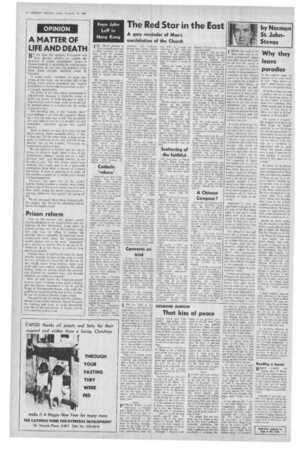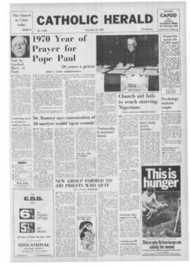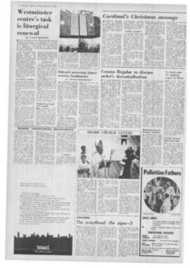Page 4, 19th December 1969
Page 4

Report an error
Noticed an error on this page?If you've noticed an error in this article please click here to report it.
Tags
Share
Related articles
There Is No God But The Leader Mao
Bishop Demands Safeguards For Hong Kong Church
E Men Who Must Deal With The Dragon
Bishop's Plea For Hong Kong Order
Challenge In Hong Kong
The Red Star in the East
A gory reminder of Mao's annihilation of the Church From John Luff in Hong Kong
'HE Church physical in 1 China is totally destroyed, its flock scattered, its children grown to manhood ignorant of any god save Mao, Vague reports tell of Chinese Christians meeting secretly, like the Christians of ancient Rome. If that is true, it is equally true that there is neither a Peter nor a Paul to venture into their Midst.
Mr. Norman Barrymaine, journalist who was released from a Chinese prison at the same time as Reuter's Anthony Gray, states that prayers are still being said by those who are imprisoned for the faith. But such prayers are said by those who have grown old in the faith. The red book of Mao's thoughts has replaced the Bible. the churches are now warehouses and secular meeting places. The red star replaces the crucifix, and a huge portrait of Mao hangs where once the priest celebrated the Holy Sacrifice.
This all began 20 years ago when I was in China, while the triumphant People's Liberation Party was sweeping all before it, demanding in the name of the people, social justice. Every enlightened person, whether Chinese or foreigner, knew that social reform was long overdue. At that time, China was riddled with corruption. the poor were ground down, and in that sense missionaries of all denominations accepted a regime which promised reform together with freedom of religious conscience.
Catholic "reform"
During the early days of the revolution. there was little interference with religious institutions, and it seemed that the Chinese Communist Party. while opposed to Christianity, would allow the foreign Christian institutions to remain in China. if only for the valuable social aid they provided.
For in 1948, the Catholic Church alone maintained some 1,500 schools. four colleges, three universities, 200 hospitals and 800 dispensaries. Meanwhile non-Catholic Christian denominations provided a further 200 hospitals, 40 nursing schools, five medical colleges, and maintained some 2,300 schools and 13 colleges.
It was not long, however, before the Communist government changed its policy. Early in 1950, the Prime Minister, Chou En-lai warned Christian religious leaders that their churches must support the new regime and cooperate in building a new China. At the same time he threatened that no new foreign missionaries would be allowed into China, while those abroad on leave would not be allowed to return. Chou En-lai also said that foreign missionaries would be allowed to remain only if they refrained from engaging in subversive activities.
In May 1950, a Christian refo'rm manifesto was issued by Chinese YMCA, YWCA, and other evangelical leaders. This manifesto called upon Chinese Christians to sever all connections with foreign Christians and their foreign-based institutions. Meetings were held up and down China summoning Chinese Christians to support the manifesto. .
The Chinese Communist Party now called upon Chinese Catholics numbering, according to the People's Daily, 3 million, to support a similar manifesto. The Catholics, through their leaders, refused to sever ties with the Vatican In an effort to arrive at a compromise, Chou En-lai met Catholic leaders and asked them to at least draw up a manifesto similar to that of the non-Catholic party. The Catholics submitted a manifesto to the Chinese Communist Party. It was returned and described as vague and meaningless.
At this stage, however. the Church was not subjected to terror in general, intimidation and squeeze were the order of the day. Fantastic demands of an arbitrary nature were made upon religious and social institutions. These demands took the form of charges for back rent and rates, and when it was pointed out that the property in question had been bought years before. the answer was that none had ever right to sell property belonging to the people of China.
Foreigners in business as well as missionaries were held as hostages until the demands of the Communists were met, at least in part. Intimidation began, as I remember it. in a childish fashion. During this period, I attended Mass at the church of Christ the King in Shanghai.
One Sunday, we found a double row of soldiers of the People's Liberation Party lined up from the pavement to the church door. To pass into the church, the congregation had to pass between the soldiers.
They did not interfere with us. but it was something of an ordeal for the local Chinese Catholics. As 1950 passed, there were more arrests, charges. and trials, as Chinese priests were rounded up. but the churches remained open. It was not until December 13, 1950, after most lay foreigners, myself included had left China, that the religious persecution began in earnest. For on that date. the Chinese Communist Party manifesto was issued, proclaiming the Catholic reform movement.
The campaign of religious persecution was now principally directed at Catholic convents which cared for unwanted children Some explanation is needed here. Up to, and including the year 1949. it was no uncommon sight to see unwanted girl babies cast out upon rubbish heaps. Even in a town like Shanghai, small boxes and sacking parcels containing the bodies of dead infants were left for the refuse men to collect. More humane parents found the steps of the convents more convenient dumping ground s for unwanted babies, some dead. some dying. all neglected.
Convents on trial
During 1951, the Chinese Communist press took this up, emphasising the high mortality rate among the infants taken into the convents. This press campaign was the more cynical and sinister, in that every Chinese knew that the unwanted female babies were either dead or dying, when left during the night at the convent doors. The press accused the nuns of murdering these babies.
Following this campaign, nuns from all over China were brought to trial before the People's Courts. One such trial was held in Canton on December 2, 1951, when five nuns from the Canadian Mission of the Immaculate Conception, were arrested. The proceedings took place in the open air before a crowd of 6,000.
During the height of the
persecution, a Shanghai Catholic managed to send a letter to Hong Kong. In part it reads: "We all have the same conviction. that our heads may fall and our blood be shed, but the Church shall not become the (Communist) reformed church: we will not remain silent while our religious superiors are falsely accused. and the Pope shall not be cut off from his (Chinese) people."
The last stand in numerical strength by the genuine Catholics defying the Com munist-led "reformed Catholics," took place in Shanghai. Here, under the courageous leadership of Bishop Kung Ping-mei, loyal Chinese Catholics stood firm for liberty of conscience. On September 9, 1955, Bishop Kung was arrested on a charge of giving information to imperial espionage agents. At the same time, police arrested prominent Shanghai Catholics, while seven foreign priests remaining in Shanghai were also held.
Scattering of the faithful
Five years later, on March 16, 1960, Bishop Kung was brought to trial and sentenced to life imprisonment. Since that day, in spite of prayers and pleas, nothing has been heard of him.
By the end of 1955, the Catholic Church in China was in her death throes. All her institutions were closed or confiscated. her priests expelled or in prison. and the faithful scattered or sharing the martyrdom of the priests and the religious.
But still Chou En-tai was not satisfied. He had. as had England's Cecil four centuries earlier, destroyed the secular aspect of the Church, but Chou En-lai had failed in any significance to replace the Catholic Church with the creature of his "Catholic reformed church." So during July 1956. Chou En-tai invited four bishops to discuss forming a Catholic Patriotic Association. Following this discussion, the Catholic persecution died down and some Chinese priests were released from prison and allowed to proceed to reopened churches in villages and small towns.
On August 2. 1957. the Catholic Patriotic Association was inaugurated. The main statement made was that agreement had been reached on the following basis. Instructions issuing from the Vatican would be dealt with in the following manner: documents would be divided into political and religious sections, while "all antisocialist instructions" would be ignored.
The final break with the Vatican occurred in March. 1958. when the so called Catholic Patriotic Association appointed two bishops-elect to the dioceses of Hankow and Wuchang. The Vatican refused to acknowledge these elections and threatened to excommunicate the two priests concerned, together with Bishop 1.i Tao-nan who was to consecrate them.
On April 3, 1958, the New China News Agency reported: "Two new Bishops of the dioceses of Hankow and Wuchang were consecrated today with all the ceremony of the Catholic rite." On September 9, 195& an Encyclical, Ad Apostolicis Principle addressed to the hierarchy, clergy, and Catholic laity of China, was published by the Vatican The Catholic Patriotic Association was condemned and the Chinese people were told that if they had to choose between man and God, they must choose God.
Since this break with the Vatican. little information has come out of China. Refugees are escaping to Hong Kong every day. Some of them arc Catholics, but the story never varies. The churches are destroyed, the priests in prison or labour camps, there is no Mass, and the flock is scattered.
All the world knows that what remained physically of the Church was utterly destroyed by the fanatical hooliganism of the Red Guards in 1966.
All the world knows how on August 24, 1966, Red Guards in Peking entered the Sacred Heart Convent. run mainly by elderly nuns from Europe, who at that stage were engaged in teaching children of foreign diplomats. The convent was wrecked and the eight foreign nuns were deported on August 31.
Foreign correspondents and local press, including radio and television reporters witnessed the pathetic walk across Lo Wu bridge into Hong Kong. One elderly nun had to be wheeled across on a barrow, as all the world saw on television. The next day this nun died. Thousands of local Chinese Catholics turned out to her funeral.
A Chinese Campion ?
Since then, the blanket of the dark has descended upon China. We hear of priests working in the fields, and a letter from a nun has been received in Hong Kong. She says little of her hardship, but says she and members of her former community "work from daylight to dusk in the fields," and adds "of course, we no longer wear our religious habits."
We hear, and I have heard personally, of those who have been betrayed and have died for the Faith.
Meanwhile. here in Hong Kong just across the border, Catholicism grows from strength to strength under the newly consecrated Bishop Franvis Ilsu. New churches are opened. large schools built, and. daily, numbers are added to the numbers of the faithful.
Yet with all this growth and enthusiasm. I see no urge to a missionary spirit_ to establish a Chinese mission to infiltrate China. 'phase who ventured would almost certainly suffer martyrdom. but somehow, perhaps because the lead has always been taken by foreign priests, there appears to be no
initiative among Chinese Catholics to form a Chinese Mission. Perhaps under Bishop Francis tisu, China will find a Chinese Edmund Campion.
blog comments powered by Disqus









